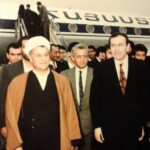In the kaza of Kiavaş/Vostan, which boasted 25 Armenian villages with a population of 6,851, generalized massacres began on 18 April in Hirj (pop. 205), where Ishkhan had been assassinated the previous day. Forty-six men were slain here.
The same day, the other villages in the eastern part of the kaza, Atanan (pop. 372) and Spidag Vank (pop. 124), were attacked and set ablaze.
A day later, Edhem, a captain in the gendarmerie, arrived in Van at the head of 300 militiamen equipped with two cannons and shelled Beltents (pop. 386).
On 18 April, the Kurdish chieftain Lazkin Şakiroğlu attacked two localities in Hayots Tsor, on the Norduz road. In Angshdants (pop. 411), the notables, including the mayor, Murad, who tried to reason with the Kurdish leader, were shot. Twenty men, however, defended the village well enough to prevent the attackers from taking control of it.
The same day, Lazkin and his men plundered the neighboring village of Eremeri (pop. 432), which was defenseless, and then massacred 80 people. A young man barricaded in a house, Sahag Kaprielian, was the only one to hold his own with the çetes; he killed seven Kurds. After nightfall, he led the survivors to Gurubaş.
The next day, 19 April, Angshdants was encircled again. Its defenders fl ed that night, leaving the way open before Lazkin and his çetes. Seventy people were killed in the village, while the others fled northeast toward the mountainous region of Varak and the Kurdish village of Temkos.
Lazkin’s third target, Gghzi (pop. 312), was counting on the protection of a local Kurdish beg, Mahmad Şarif. Şarif intervened, but to no avail: on the afternoon of 19 April, 60 people were massacred in Gghzi, including Hovsep Aloyan, Harutiun Garabedian, Vartan Manukian, and Father Mgrdich. Retrenched in a house, eight young men resisted until nightfall, when they fled to Pertag and Varak.
On 20 April, Lazkin attacked Gem (pop. 547) and Ankgh (pop. 678), which lay south of Van in Hayots Tsor. He was backed up by two other çete leaders, Jıhankir and Sadul. He had two cannons at his disposal. The inhabitants of Musgavents/Mashdag (pop. 394) and Gzltash/Kızıltaş (pop. 314) had also thronged into Gem, where they were defended by 60 armed men who were unable to fend off the çetes’ attack.
The survivors poured onto the road to Ankgh, where 150 people were massacred. The same day, Ankgh was attacked in its turn; 270 villagers were slain there, while 300 fled toward the Khoshap River, where 100 more perished.
Thus, a total of 700 people were massacred on 20 April.
What was left of the population of the villages in the vicinity gathered in Ishkhani Kom (pop. 409), located between the Semiramis Canal and the Khoshap. On the afternoon of 20 April, Lazkin, Jıhankir, Sadul, and their çetes, who had been joined by the contingent under Captain Edhem to form a force of around 1,000 men equipped with four cannons, attacked the village, defended by 80 men.
Eight hundred men of all ages retreated to Varak, to the east, while the women and children set out for Ardamed, where 300 were massacred. Three thousand people, however, succeeded in reaching either Van or Varak.
A total of some 2,000 survivors from Beltents, Gghzi, Spidag Vank, Atanan, and Kızıltaş took refuge on Mt. Gghzi, where they remained for around three weeks. On 10 May, the kaymakam of Kiavaş arrived with 200 militiamen and attacked the Armenian villagers.
Some fled toward Van and Varak; the bulk of the group succeeded in reaching the plain of Pzantashd in the northwestern part of the kaza of Şatak/Shadakh, where people from Karcikan/Garjgan and the villages in the western part of the kaza of Kavaş had gathered.
To be continued
Note- this chapter is from Raymond Kévorkian’s book ARMENIAN GENOCIDE: A Complete History, pp. 324-325.
Map – The vilayet of Van at the beginning of the 20th century, http://www.houshamadyan.org











